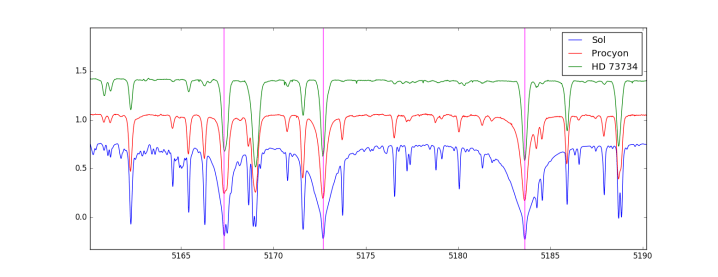“We are star stuff,” said Carl Sagan. That short statement lacks a certain level of detail. Let’s delve in a little bit. Mostly, he meant that supernovae explosions, the death throes of massive stars, manufacture many of the elements that make up your bodies. That’s true for the oxygen atoms in the water (H2O) in which your corpuscles flow. The hydrogen atoms in your water, however, are protons, thinly clothed with one electron but otherwise naked, left over from the hot big bang.
“How do you know that?” one might reasonably ask.
 “Spectroscopy,” I myself might answer.
“Spectroscopy,” I myself might answer.
“Huh?” one might reasonably reply.
“Well, we look at the spectrum of supernovae and gas we might reasonably expect to be enriched by supernova ejecta and we see heavy elements.”
“What do you mean by ‘see?'”
“Ah!” (That’s the sound I make when I have a bright student who asks a very clever question. Rather than feeling a rush of pleasure from my expression of approval, however, most misconstrue my bark of avid admiration and ask if I’m suddenly in pain.)
It’s like this. Every element has its own cloud of electrons. The outermost electron can be easily pestered, for example by heating up a small sample of the element. Such pestering flips the atom into an “excited” state. There are hundreds of excited states in simple atoms and thousands of them in complex atoms. What happens next is awesome. The electron settles back down. But the act of settling down releases a small packet of light at a very precise wavelength (color). This single wavelength is what we call an emission line.
When I say “very precise,” I mean about a few parts in ten million. That’s an important number. If you quote your wavelength in Angstroms (one ten-billionth of a meter), an example would be the transition between a couple of electronic configurations in the element Magnesium. The one I’m thinking of is at wavelength 5167.3216 Angstroms. The “very precise” restriction means you need all of those eight digits. If you measure a wavelength of 5167.3226, for example, it is 0.001 Angstroms different and it cannot be the same line!
Every element has a unique fingerprint of emission lines. You can even buy a poster of it.
Now, let’s get cosmic. Let’s take a really good spectroscope and point it at the sun and a couple of other stars. The result might look like this:

The bottom axis is wavelength, and we are zoomed on about 30 Angstroms of spectrum, here. The Y axis is just the amount of light coming in, but only the middle trace is properly scaled. The top and bottom spectra are arbitrarily shifted vertically for clarity. I marked vertical lines at the wavelengths of three magnesium emission lines measured here on earth. The stars have dips (absorptions) at those wavelengths.
Could that be coincidence? The emphatic answer is no. One wavelength coincidence could be a chance alignment. Sometimes stars travel and Doppler shift their wavelengths a little bit. But two lines matching in the correct wavelength ratio, each to one part in ten million? Two lines pretty much seals the deal. Three is just overkill. The same magnesium we have in the lab just has to be the same magnesium that we see in the spectra of distant stars.
How much magnesium? Well, that’s a harder question because we have to know the temperature and density of the photospheres to find that out. A little modeling is required. For stars, we get solid answers. For more exotic celestial critters the answers get rougher.
What about all those other little dips and wiggles? They indicate other species. In that little bit of spectrum, you’ve also got neutral titanium, once-ionized titanium, neutral iron, once-ionized iron, and several other common elements.
Nifty. We have the same roughly 80 elements here, in our planet and bodies, as we have in outer space.
In these unsettled time, it’s nice to be sure about a thing.